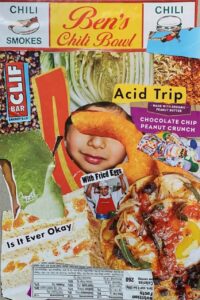When COVID-19 disrupted life at MIT, library staff naturally thought to look to the archives for similar events in Institute history, such as the 1918-19 flu pandemic. While they found surprisingly little documentation from that time—the Institute Archives hadn’t yet been established—the department of Distinctive Collections (DDC) has been working hard to ensure this will not be the case when looking back on the current pandemic and its effects on the MIT community. A new DDC project, Documenting COVID-19, aims to collect and preserve our present moment as a valuable resource for the future.

Detail of eggandbars, a page from Julia Chatterjee’s Quarantine Zine.
Broadening the perspective
The Documenting COVID-19 project developed when a professor in the History department approached DDC staff soon after the MIT community left campus in March. His students would be documenting the situation for class, and he asked what forms they would need to complete to donate their work to Distinctive Collections to be a part of the historical record. This prompted DDC staff to explore how they could open up the opportunity to donate materials to the MIT community more broadly.
“We were already collecting the Institute records, the decisions that were made, the websites that different departments, labs, and centers put up, and the policies that were affecting campus. Collecting what’s happening with students, staff, and alumni just rounds out that picture,” says Mikki Macdonald, collections strategist for DDC, who is leading the project. “This effort is a different view into what’s going on and how the decisions the Institute is making are affecting everyone’s daily life.”
The project invites anyone in the MIT community— students, staff, faculty, researchers, alumni, and others—to contribute materials that will help document the diverse experiences of the pandemic and the resulting changes to life and learning at MIT. Donations can take the form of handwritten or typed documents, audio or video recordings, scrapbooks, drawings, photography, music, and more.
Picturing a moment in time
Since the project launched in May, DDC has received a steady stream of donations in a wide range of formats. Among the notable submissions were music playlists that MIT students compiled while they were moving out of their dorms. “It’s not something that I would have ever thought of,” says Macdonald. “But music really encapsulates an event for a lot of people, so I think it will be really interesting to see what music was helping them get through that chaotic situation.”
Other submissions include zines (self-published magazines); photographs capturing the campus after it had emptied out; documentation of student volunteer efforts to provide personal protective equipment to Boston organizations; and personal reflections and essays about leaving campus and going home, some candidly sharing the toll of worrisome medical situations and overall stress.
“I think it’s a cathartic experience for some to be able to put their thoughts and feelings down and know that it’s going to be somewhere that other people can read them,” says Macdonald.
DDC plans to make these experiences available to future readers through digital exhibitions and by offering the material for classes to use. With many universities undertaking similar collecting initiatives, the opportunity to compare collections across the country and around the world will be rich for future researchers.
Collecting history as it happens
Launching the project quickly meant addressing several issues: what questions to ask potential donors, what would be the rights implications, what would DDC ask people to provide, what would it would be comfortable taking, and how do the Libraries do this in a responsible, respectful, and ethical way? Learning more with each new donation, staff now have a blueprint for launching similar collecting efforts in the future—hopefully next time for a more positive event, jokes Macdonald, who is eager to replicate the project, perhaps by partnering with graduating classes or alumni classes coming back for reunions.
“We can learn from what’s currently going on,” she says. “His-tory can be last year; it doesn’t have to be a hundred years ago. We can be active in collecting in the community and be a partner and say ‘we want to tell your story and make sure you have a voice.’”
Collecting history as it happens has increasingly been a priority for Distinctive Collections. In 2016, for example, after the MIT community shared thoughts and fears on posters in Lobby 7 in the wake of the presidential election, DDC decided to preserve and digitize the posters as part of the memory of the Institute. With the COVID-19 project and future collecting initiatives, DDC has the opportunity to be proactive and actively build collections with the community.
“It’s been exciting to position DDC as a unit that is about now,” says Emilie Hardman, head of DDC. “We used to think about our collections as ‘the history of MIT,’ but we’re the present and the future, too. All of these materials will help tell stories and inform research in ways we can’t even know right now.”
To learn more about Documenting COVID-19 or to donate, visit libraries.mit.edu/distinctive-collections


